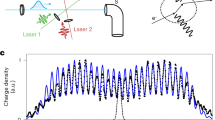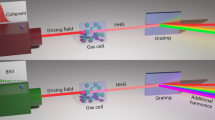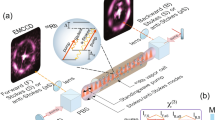Abstract
The advent of the laser as an intense source of coherent light gave rise to nonlinear optics, which now plays an important role in many areas of science and technology. One of the first applications of nonlinear optics was the multi-wave mixing1,2 of several optical fields in a nonlinear medium (one in which the refractive index depends on the intensity of the field) to produce coherent light of a new frequency. The recent experimental realization of the matter-wave ‘laser’3,4—based on the extraction of coherent atoms from a Bose–Einstein condensate5—opens the way for analogous experiments with intense sources of matter waves: nonlinear atom optics6. Here we report coherent four-wave mixing in which three sodium matter waves of differing momenta mix to produce, by means of nonlinear atom–atom interactions, a fourth wave with new momentum. We find a clear signature of a four-wave mixing process in the dependence of the generated matter wave on the densities of the input waves. Our results may ultimately facilitate the production and investigation of quantum correlations between matter waves.
This is a preview of subscription content, access via your institution
Access options
Subscribe to this journal
Receive 51 print issues and online access
$199.00 per year
only $3.90 per issue
Buy this article
- Purchase on Springer Link
- Instant access to full article PDF
Prices may be subject to local taxes which are calculated during checkout



Similar content being viewed by others
References
Franken, P. A., Hill, A. E., Peters, C. W. & Weinreich, G. Generation of optical harmonics. Phys. Rev. Lett. 7, 118–119 (1961).
Maker, P. D. & Terhune, R. W. Study of optical effects due to an induced polarization third order in the electric field strength. Phys. Rev. 137A, A801–A818 (1965).
Mewes, M.-O. et al. Output coupler for Bose-Einstein condensed atoms. Phys. Rev. Lett. 78, 582–585 (1997).
Hagley, E. W. et al. Awell collimated quasi-continuous atom laser. Science(in the press).
Anderson, M. H. et al. Observation of Bose-Einstein condensation in a dilute atomic vapor. Science 269, 198–201 (1995).
Lens, G., Meystre, P. & Wright, E. W. Nonlinear atom optics. Phys. Rev. Lett. 71, 3271–3274 (1993).
Dalfovo, F., Giorgini, S., Pitaevskii, L. P. & Stringari, S. Theory of trapped Bose-condensed gases. Rev. Mod. Phys. 71(in the press).
Goldstein, E. V., Plättner, K. & Meystre, P. Atomic phase conjugation. Quantum Semiclass. Opt. 7, 743–749 (1995).
Trippenbach, M., Band, Y. B. & Julienne, P. S. Four wave mixing in the scattering of Bose-Einstein condensates. Opt. Express 3, 530–537 (1998).
Kozuma, M. et al. Coherent splitting of Bose-Einstein condensed atoms with optically induced Bragg diffraction. Phys. Rev. Lett. 82, 871–875 (1999).
Petrich, W., Anderson, M. H., Ensher, J. R. & Cornell, E. A. Stable, tightly confining magnetic trap for evaporative cooling of neutral atoms. Phys. Rev. Lett. 74, 3352–3355 (1995).
Shen, Y. R. The Principles of Nonlinear Optics 249–251 (Wiley, New York, (1984).
Acknowledgements
We thank K. Burnett, C. W. Clark, M. Kozuma and D. E. Pritchard for discussions. This work was supported in part by the US Office of Naval Research and NASA.
Author information
Authors and Affiliations
Corresponding author
Rights and permissions
About this article
Cite this article
Deng, L., Hagley, E., Wen, J. et al. Four-wave mixing with matter waves. Nature 398, 218–220 (1999). https://doi.org/10.1038/18395
Received:
Accepted:
Issue Date:
DOI: https://doi.org/10.1038/18395
This article is cited by
-
Nonlinear plasmonics: second-harmonic generation and multiphoton photoluminescence
PhotoniX (2023)
-
Continuous Bose–Einstein condensation
Nature (2022)
-
Data-driven model discovery of ideal four-wave mixing in nonlinear fibre optics
Scientific Reports (2022)
-
Coherent satellites in multispectral regenerative frequency microcombs
Communications Physics (2020)
-
Topological photonic crystals: a review
Frontiers of Optoelectronics (2020)
Comments
By submitting a comment you agree to abide by our Terms and Community Guidelines. If you find something abusive or that does not comply with our terms or guidelines please flag it as inappropriate.



